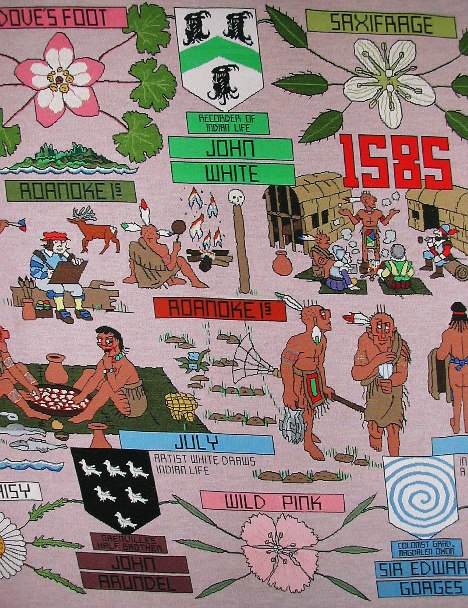|
Back to 1585 Menu

Innocently
the Indians welcome the white men into their villages and trinkets are exchanged by the English for furs and skins, a very
worthwhile bargain for the colonists. However the accord does not last long for one of the natives – centre picture
– steals a silver cup and though Grenville demands its return, it is not forthcoming.
Note the Indian to the left of
the thief – he’s just come back from a fishing trip. To his right a family watches the convivial party going on
between the settlers and their hosts seated around a camp fire. The Indians do not live in wigwams but huts.
Colonist Sir Thomas Wise (arms
shown here) has come on this expedition with his friend Edward Kelly (scene one). Wise comes from Sidenham close
to Marystowe in Devon which is only two miles from the Kelly home. (Wise’s future does not lie in Virginia as does
Kelly’s but back in England, for he will die in 1629 and be buried in Marystowe Church where his wonderful canopied
tomb shown on the right-hand side of this scene is a great feature, as is his actual helmet, which hangs on the wall nearby.
Sidenham, the family home was sold in 1937 then used as a school until the end of the second World War when it returned into
private hands).
The other adventurer, identified in this scene is Sir Edward Gorges. He comes from
Clareton Manor in Somerset. (Note his coat-of-arms shield here with the unusual design in the shape of a swirl. This is because
“Gorges” is another name for a whirlpool. Edward is an elder brother of the famous Sir Ferdinando Gorges, destined
to become the first Governor of Maine and a dynamic promoter of colonisation in Virginia. However, Edward’s future will
not be in the New World but mean a return to England to become High Sheriff of Somerset in 1609 and die in 1624 aged 60).
|
 |
|
|
|
 |
|

SAXIFRAGE Saxifraga. ‘Matthiolus saith, that Calceolarcus
of Verona mightily commended this plant to him, for the singular qualitie that it had to expell or drive forth the stone of
the kidnies’. Gerard.
MULLEIN Verbasum. ‘Moths, butterflies
and all manner of small flies and bats do resort to the place where this herb is laid or strewed ’. Gerard.
|
 |
|
|
|

